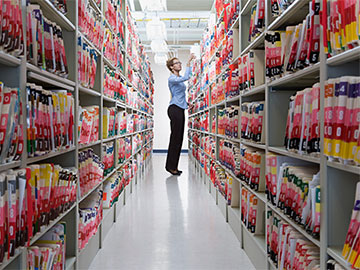In this Article


Written and reported by:
By Emily Polner
Contributing Writer
Pharmacists and pharmacy technicians often work side by side, performing similar duties such as filling prescriptions, conversing with patients, doctors, and insurance companies, and keeping pharmacies clean, safe, and up to standards.
Despite these similarities, pharmacists and pharmacy technicians have different educational backgrounds, job responsibilities, and salaries.
Overview
Pharmacy technicians mainly assist with clerical work within a pharmacy or hospital. Pharmacists are chiefly responsible for ensuring that patients’ medications are filled properly and safely.
“Successful pharmacy technicians are detail-oriented team players, and they have impeccable communication skills,” says Rhea Elizabeth Angeles, PharmD, an executive fellow with the Pharmacy Technician Certification Board and a former PTCB-certified pharmacy technician (CPhT). “Pharmacy technicians are the backbone of every pharmacy and play a critical role in maintaining a smooth workflow.” Pharmacists, on the other hand, “must be confident, effective leaders with strong moral character, and have the ability to interpret complex information,” Angeles says. “Pharmacists are responsible for utilizing their vast clinical knowledge to ensure the safe and effective use of medications.”
Roles and Responsibilities
Both pharmacists and pharmacy technicians speak directly with patients, doctors, and insurance companies. But a pharmacist is a supervisor and manager who oversees the work of pharmacy technicians. Here’s a closer look at the roles and responsibilities for each profession.
Pharmacy Technician
Pharmacist
Pharmacy technicians work alongside pharmacists at chain and independent pharmacies, as well as in the pharmacy department at retail stores, grocery stores, and hospitals.
Pharmacists can be found most commonly in retail pharmacies and hospitals. Some pharmacists go on to work in clinical research and development settings or become pharmacy scholars or university professors.
Legally, pharmacy technicians can fill patient prescriptions, so long as they are reviewed by a pharmacist before they are given out. Pharmacy technicians are not permitted to recommend medications to patients, including over-the-counter medications and supplements.
Education
While there is a slight overlap in the subjects they study, pharmacy technicians and pharmacists have different education backgrounds and requirements.
Pharmacy technician programs are typically one to two years and cover core courses in:
Pharmacists attend six to eight years of school with a foundation in chemistry, biology, and math, and advanced courses in subjects such as:
How to Get There
Pharmacy Technician
In some states, pharmacy technicians must complete a pharmacy technician certificate program or earn an associate degree. These programs help aspiring pharmacy technicians prepare for and pass the Pharmacy Technician Certification Exam.
In other states, no education beyond a high school diploma is needed. However, previous work experience is highly desired for those who choose not to enroll in a pharmacy technician education program.
Pharmacist
To earn a Doctor of Pharmacy (PharmD) degree, six to eight years of study are required. There are two education tracks:
Both PhD tracks include extensive clinical work, interacting with patients and doctors under the guidance of a professional pharmacist.
Licensing and Certification
Licensing and certification vary by state for pharmacy technicians, but all states require pharmacists to take a national licensing exam and an exam on state law to practice.
Pharmacy Technician
Licensing requirements are set by the states and fall into three categories:
- License/registration required
- National certification and license/registration required
- No license or certification requirements
In states that require certification, pharmacy technicians must pass one of two certification exams. Pharmacy technicians with formal training and those with work experience only can qualify for either one:
- The Pharmacy Technician Certification Exam (PTCE), which is administered by the Pharmacy Technician Certification Board (PTCB)
- The Ex Certified Pharmacy Technician (ExCPT) exam, which is administered by the National Healthcareer Association (NHA)
Since each state has its own certification requirements, make sure you understand the requirements for the state you’re looking to work in.
Pharmacist
Pharmacists must take two licensing exams after completing a PharmD program:
- The North American Pharmacist Licensure Exam (NAPLEX)
- Either the Multistate Pharmacy Jurisprudence Exam (MPJE) or a state jurisprudence exam. You’ll need to contact your state’s licensing board to determine which jurisprudence exam you need to take.
After you’ve taken your exams, you can apply for licensure. Some states may require you to pass a background check, submit proof of your pharmacy internships, or complete additional training.
Licensed pharmacists can take exams to earn specialized certifications from the Board of Pharmacy Specialties (BPS) in any of the following areas:
- Ambulatory Care
- Cardiology
- Compounded Sterile Preparations
- Critical Care
- Geriatric
- Infectious Diseases
- Nuclear
- Nutrition Support
- Oncology
- Pediatric
- Pharmacotherapy
- Psychiatric
- Solid Organ Transplantation
Becoming a pharmacy technician is a great steppingstone to becoming a pharmacist. Many pharmacy technicians make the decision to pursue a PharmD degree after their experiences working in a pharmacy. Entering pharmacy school with hands-on work experience can put you at an advantage over your classmates.
Salary and Job Outlook
Given the years of education required to be a pharmacist, plus the responsibilities of the job, it’s no surprise that pharmacists earn significantly more than pharmacy technicians. According to the U.S. Bureau of Labor Statistics, the median salaries for pharmacy tech and pharmacist jobs are:
The job outlook for these professions tells a slightly different story. While pharmacy technician jobs are expected to grow by 5.6% through 2032, roles for pharmacists are expected to grow 2.6% through 2032, slower than average.
Pharmacy jobs are on the decline, especially in drug and other retail stories, because more people are getting their prescriptions online, according to the BLS. Another factor is that technicians are doing more of the tasks previously done by pharmacists, such as preparing some types of medications.
One positive spot for pharmacists will be healthcare settings such as hospitals and clinics, where more pharmacists are expected to be needed to oversee medications for patients.
Pharmacy technician roles are growing in line with the average for all jobs. This is due in part to the growth of the nation’s aging population and a rising need for prescription medication. Technicians can expect to take on a greater volume of this work.
Which Career is Right for You?
Pharmacy technician roles are great for those who would like a fulfilling career in health but don’t necessarily want to pursue a four-year degree.
However, if you want a managerial role, a higher starting salary after finishing school, or to conduct clinical research, you may be more suited for a career as a pharmacist.

With professional insight from:
Rhea Elizabeth Angeles, PharmD
Executive fellow, Pharmacy Technician Certification Board, a former PTCB-certified pharmacy technician (CPhT)
You may also enjoy:


